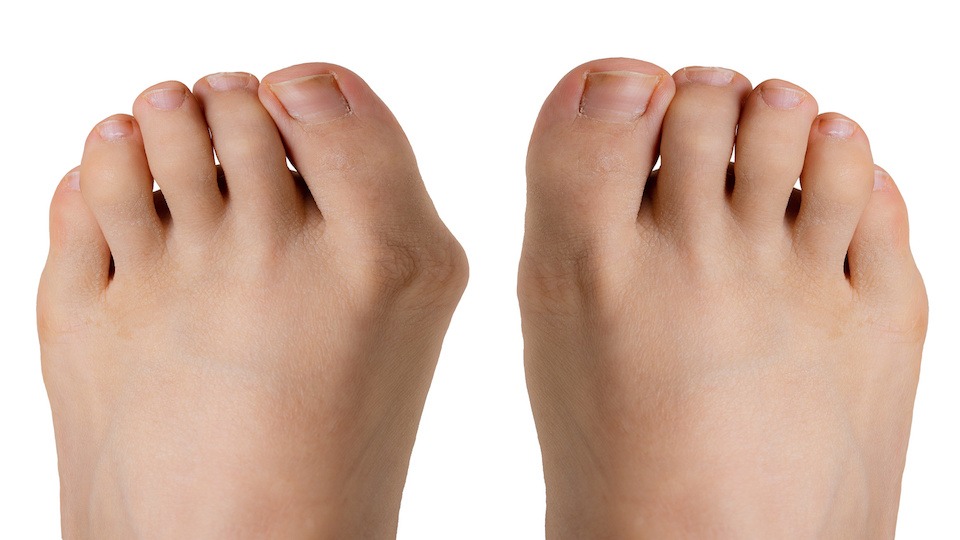For an otherwise very well put together 80-year-old woman, the huge hole in her right shoe was a shocker…that is, until I saw her foot. Her big toe was pointing sideways and there, at the base of her big toe was an enormous bunion. It was so large that there was no way that it could fit inside of a normal shoe, so she just cut a hole in them and went on with her business. Bunions are an extremely common foot deformity…this article will help you understand what they are, how they develop, and how to manage them…before you start cutting holes in your shoes.
-JL
Do you have a large bump protruding at the base of your big toe? If so, it is likely that you have a hallux valgus or what is commonly known as a bunion. Bunions appear when the big toe itself deviates out of position and pushes against the second toe. This puts a strain on the joint at the base of the big toe which then enlarges, protrudes, and can become quite painful.
The joint at the base of the big toe joint has a lot of responsibility. It plays an important role in weight bearing and balance when you stand, walk, run…or do anything else on your feet. This is why bunions can be such a painful and debilitating condition. In advanced cases, the joint can become so stiff and sore that it is hard to wear shoes.
Are your shoes to blame?
Although bunions do run in families, they can also be brought about by gait abnormalities and/or inappropriate footwear. According to podiatrist Georgeanne Botek, DPM, Head of the Section of Podiatry and Medical Director of Cleveland Clinic’s Diabetic Foot Clinic, women are at much greater risk for developing bunions than men.
Is surgery the only option?
Once a bunion is fully developed, surgery is required to reduce the enlargement…but there are some ways to ease the pain and pressure and slow the progression of a developing bunion. Here are some ideas:
- Wear the right shoes: Choose low heeled shoes with a wide toe box and good support through the arch.
- Splints: There are a variety of over-the-counter and prescriptive splints that can help to hold the big toe in better alignment to reduce the rate of progression.
- Orthotics: many people with bunions have an abnormal gait pattern called “pronation” which puts extra pressure on the joint at the base of the big toe. Identifying and correcting pronation with orthotics can help to change the forces on the joint and decrease the risk and rate of progression of bunion formation.
- Watch your weight: The bigger you are, the more pressure there will be on the bunion. Maintain a healthy weight by eating wisely and exercising daily.
- Ice up: Applying an ice pack to the bunion helps to reduce pain and decrease inflammation and swelling. Use an ice pack for five minutes at a time for relief.
- Warm soak: Fill a soaking tub with warm water and Epsom salts and soak the affected foot. The warm water and salts will help ease pain and inflammation. You can also add ½ teaspoon of cayenne pepper which with further reduce inflammation.
Homemade Pain Reliever
Apply this pain reliever topically to swollen and sore joints.
Ingredients:
- ¼ cup organic, unrefined coconut oil
- ¼ cup extra-virgin, organic olive oil
- 1 tablespoon beeswax
- ¼ teaspoon ground pepper
- ¼ teaspoon ground ginger
- 20 drops peppermint essential oil
- 20 drops eucalyptus essential oil
- 20 drops clove oil
Fill a small saucepan with water and then find a heatproof bowl that will fit inside the pan. Add the coconut and olive oil to the bowl, along with the ground pepper and ginger. Bring the water to a simmer, and then let the mixture warm in the hot water for 20 minutes. After 20 minutes of steeping, add the beeswax and heat until melted.
Place a strainer over a small bowl. You can use a coffee filter for extra help. Carefully remove the melted mixture from the saucepan, and pour over the strainer to keep any ginger or ground pepper bits out of the salve.
Next, add the peppermint and eucalyptus essential oils. Carefully pour the warming rub in a small sealable container, and allow it to set at room temperature for about two hours. Seal with a lid and use as needed.
Foot Exercises
Regularly performing foot exercises can help keep the toe joints flexible and prevent bunions from getting worse. Try these easy exercises.
Toe Circles: Hold your big toe and make as big of a circle as you can in a clockwise direction then a counterclockwise direction. If this causes a lot of pain do not do it.
Marble Pick Up: This exercise will help keep your toes and feet nimble. Place some marbles on the floor in front of you and use your toes only to pick them up and put them in a bowl.
Take a Beach Walk: Walking barefoot on the beach massages your feet and helps toes to get stronger. This is especially beneficial if you have arthritis.
-The UpWellness Team









